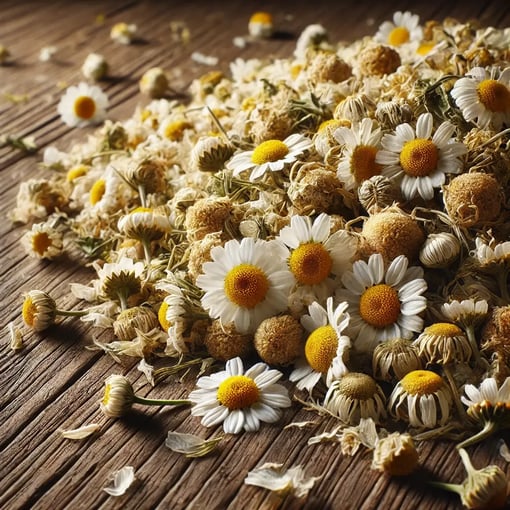Chamomile: A Gentle Ally for Body, Mind, and Spirit
There are certain plants that feel like old companions, as though they’ve been quietly walking beside us all along. Chamomile is one of them.
For centuries, chamomile has stood with us as a steady, nurturing presence. It’s soothed our anxious hearts, softened our digestive knots, and wrapped us in warmth when the weight of the world felt too heavy. But beneath its soft appearance lies a deep reservoir of medicine—both physical and spiritual—that continues to serve us today.
In this introduction to chamomile, we’ll explore her rich history, her clinical properties, her chemical constituents, and her profound gifts as a spiritual ally for those of us doing the deeper work.

Botanical Identity and Growing Habits
Chamomile belongs to the Asteraceae family—sometimes called the daisy family—and exists primarily in two species that are commonly referenced in Western herbalism:
-
Matricaria chamomilla (German Chamomile)
-
Chamaemelum nobile (Roman Chamomile)
Both species offer healing properties, but the chamomile most often used in Western clinical herbalism is Matricaria chamomilla. Roman chamomile is frequently used in essential oils, but less often internally.
Chamomile thrives in full sun and well-drained soil, growing easily in temperate climates across Europe, Western Asia, North America, and beyond. Like many of our herbal allies, she adapts well to different environments—mirroring the flexibility and resilience she helps restore within us.
The Long History of Chamomile
Chamomile’s history is long and deeply woven into the threads of human experience. The ancient Egyptians honored her as sacred to the sun god Ra, using her for fevers and calming the spirit. The Greeks and Romans turned to chamomile for digestive complaints, restlessness, and emotional distress. Throughout medieval Europe, chamomile was scattered across stone floors during festivals and ceremonies, releasing her calming scent into the air.
Centuries later, her medicine remains as relevant as ever. Chamomile tea sits in countless kitchens worldwide, offered to children, the elderly, and everyone in between. In its simplicity lies its enduring power.
Materia Medica: Chamomile’s Healing Profile
At its core, chamomile is a gentle yet potent:
-
Nervine (calming to the nervous system)
-
Carminative (soothing to the digestive system)
-
Antispasmodic (relaxing smooth muscle tension)
-
Anti-inflammatory
-
Mild analgesic (pain-relieving)
-
Mild sedative
Her Latin name, Matricaria, shares its root with mater, meaning “mother.” That name is not accidental. For centuries, chamomile has been seen as a plant that embodies motherly care—nurturing, steady, and deeply protective without being overbearing.
Constituents: The Plant Chemistry Behind the Medicine
Chamomile may feel gentle, but her chemistry is strong and dynamic. Key constituents include:
-
Volatile oils: Primarily bisabolol and chamazulene, which are responsible for much of chamomile’s anti-inflammatory and calming actions.
-
Flavonoids: Especially apigenin, which supports chamomile’s ability to calm the nervous system, reduce anxiety, and act as an antioxidant.
-
Polyphenols & coumarins: Offering gentle circulatory and anti-inflammatory support.
-
Mucilage: Coating and soothing irritated tissues, particularly within the digestive tract.
These compounds work together to create chamomile’s unique ability to relax the nervous system, calm the gut, and quiet overactive minds.

How Chamomile Works: Mechanisms of Action
Chamomile interacts with multiple systems in the body, offering broad support:
-
Nervous System: Apigenin, one of chamomile’s flavonoids, binds to GABA receptors in the brain. This gently promotes relaxation, reduces anxiety, and supports restful sleep—without sedating or causing dependency.
-
Digestive System: Its carminative and antispasmodic properties help relax the smooth muscles of the gastrointestinal tract, easing cramping, gas, and indigestion.
-
Inflammation: Bisabolol and chamazulene reduce systemic inflammation, benefiting both gut health and overall inflammatory load.
-
Musculoskeletal Tension: Its antispasmodic actions assist with muscle tension, menstrual cramps, and tension headaches.
Physical Applications of Chamomile
In clinical practice, chamomile is useful for:
-
Indigestion, bloating, gas, and mild IBS symptoms
-
Restlessness, insomnia, and difficulty falling or staying asleep
-
Anxiety, nervous agitation, and emotional overwhelm
-
Menstrual cramps and mild muscle tension
-
Infant colic and teething discomfort (with appropriate guidance)
Chamomile’s safety profile is excellent for a wide variety of people, including children, elders, and during pregnancy. The main caution is for individuals with known allergies to plants in the Asteraceae (daisy) family.
In my own practice, I primarily work with chamomile in three forms:
-
Teas (infusions)
-
Tinctures
-
Essential oils (with appropriate caution and clinical discretion)
I do not personally use chamomile in topical applications or hydrosols in my clinical offerings, as I reserve her medicine for internal and energetic use where I find her gifts shine most profoundly.
The Spiritual Medicine of Chamomile
Chamomile’s gifts extend far beyond the physical body. In spiritual herbalism, she offers a stabilizing presence for those navigating emotional intensity, deep trauma work, or energetic overwhelm.
Chamomile gently soothes the wounded inner child, particularly where early safety or nurturance was missing.
She softens emotional rigidity, anxiety, and mental spiraling.
She helps calm an overstimulated solar plexus and heart space.
She allows us to feel safely held as we open to spiritual insight.
She invites surrender, relaxation, and nervous system regulation in the midst of uncertainty.
Her medicine reminds us that we do not need to force healing. We only need to create the right conditions for release, softness, and natural re-alignment.
Often, when I work with clients moving through complex emotional layers, I find that chamomile is like a hand resting gently on the shoulder—reminding the body that it can let go.
Ritual and The Healing of Simplicity
One of chamomile’s greatest gifts is her accessibility. The simple act of preparing a strong cup of chamomile tea becomes a form of medicine all its own. The warmth of the mug, the honey-sweet aroma, the slowing of breath—these are acts of nervous system repair.
In times of grief, uncertainty, or exhaustion, chamomile offers a steady presence that says: "You are safe. You can soften now. You are held."
A Plant That Meets You Where You Are
Chamomile asks for very little. She grows easily, adapts to many soils, and offers her medicine to those who need it most. Her sweetness is not naïve; it’s the sweetness of deep wisdom. She knows what it means to soften the body so the spirit can breathe.
In my practice at Brahmaloka Healing Arts, chamomile has become one of my most trusted allies for clients who are moving through anxiety, trauma release, nervous system regulation, digestive distress, and emotional recalibration. She remains a steady companion for many of my clients as they begin to build trust within their own embodied experience again.
Chamomile is gentle medicine—but never mistake gentleness for weakness. True healing rarely arrives through force. Chamomile reminds us that sometimes, safety is the greatest catalyst for transformation.

I hope this introduction to chamomile inspires you to deepen your relationship with this beautiful plant. If you’re ready to explore more herbs, plant medicine, and energetic healing, be sure to join me on my YouTube channel "Learn Herbs with Lauren", where we’ll continue this journey together.
With gratitude,
Lauren Mangelinckx XOXO
Brahmaloka Healing Arts
You may also like
These related articles
